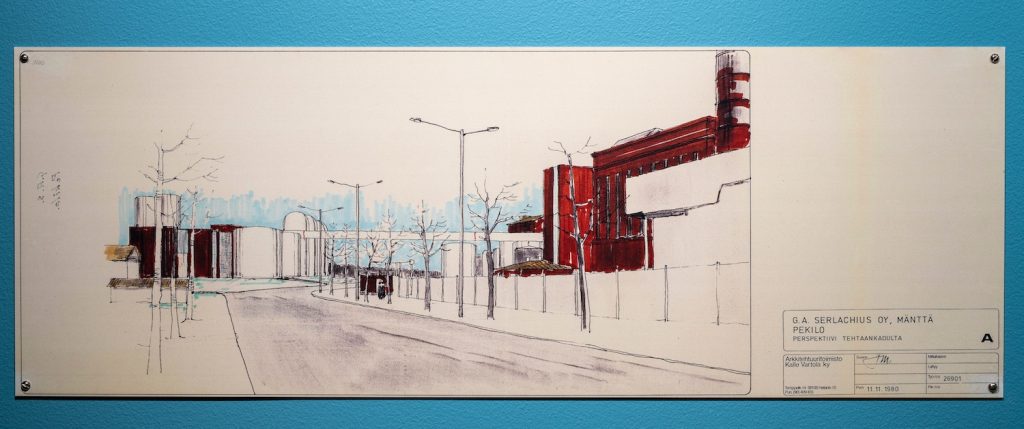
Pekilo Mill
MAY 2022
Forty years ago, a new industrial building was completed on the eastern shore of Koskelanlampi Pond, in Mänttä. Architectural office Kalle Vartola designed the building. A perspective drawing from Tehtaankatu Street in Mänttä belongs to the drawing collection of the Serlachius Museums.
For G. A. Serlachius Ltd, Pekilo Mill was foremost an environmental investment, even though pekilo, its main product, was protein meant for animal consumption. The fodder was used mainly to feed poultry and cattle. The process included growing fungal culture of Paecilomyces variotii in a continuous process in the mill. From the name of the fungus was derived also the names pekilo process and pekilo protein. The annual production capacity of the mill reached eight thousand tonnes.
Pekilo Mill contained ultra-modern technology including computer-controlled processes. Instead of the personnel needing to go around and turn spigots or valves by hand, everything could be controlled by applying a stick on a touch screen.
Closure of the sulphite pulp mill in 1991 resulted in running out of raw material which also ended the operations at the Pekilo mill. Subsequently the mill was left in the state of Sleeping Beauty for ten years. All machinery and equipment were dismantled, and all power was cut from the mill. Workers’ pencils, rulers and erasers were left behind in drawers and on tables. Girlie calendar from 1991 was left hanging on the wall.
Established in 1993, Mänttä Art Festival needed new exhibition spaces. Early on, they had been able to use in summertime free of charge the empty buildings owned by the paper company. The company, however, tried to find new year-round function for the facilities, and some of them were also demolished as redundant, such as the previous facilities of company’s vocational school. Finland’s most comprehensive review of contemporary art, Mänttä Art Festival found itself in a situation where it had no exhibition space. Turn of the century saw beginning of discussions as to whether the former Pekilo Mill could become a future exhibition space.
The building had suffered from serious damages as water had found its way through the roof. During the first inspections one could see vast icickels hanging from the ceiling and floor reminded of an ice rink. However, the space was tall and spacious, and in its clear simplicity, very suited for contemporary art. Kuvataiteen ystävät, the local registered association Friends of Art, made a bid of one Finnish Mark for the land and the building. After negotiations, the purchase price was 175 000 Finnish Marks.
Architect Anneli Vehkaniemi was invited to design the changes in the use of the industrial building. Various EU project funding were applied and granted for the mill’s modification project. Local authority in Mänttä also supported the project with financial contributions, necessary in such projects. The association of the friends of art took bank loans in own contribution of the project. Large sums of sponsorship money were gathered by selling advertising signs. Construction work was carried out as community work and as intervention work targeted for the unemployed.
The first exhibition was opened in the building exactly twenty years ago, in June 2002. It was VII Mänttä Art Festival curated by Kaisu Koivisto. Inspired by its historical past, the new exhibition space was named Pekilo.
Sampo Linkoneva
Serlachius Museums’ Photographer
Chair of the Board of Mänttä Art Festival / Managing Director 1993–2007

